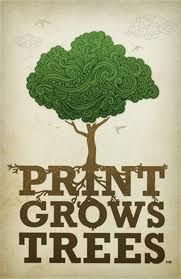
Let me state right up front: I love trees! I love how they look. I love the shade they provide. I love how the leaves turn bright colors in the fall. Upon purchasing my house in eastern Massachusetts 20 years ago, one of the first things we did was to plant a flowering pear and a dogwood tree on the property. They’re beautiful; and watching them grow and thrive gives me great pleasure. In the warm weather I love lying on my hammock under the big elm tree next to my house.
So I hope I’ve established my bona fides as a tree lover in order for me to also say: I love printing! I love envelopes! I love the paper industry! That felt good to say. But the point of this post is that the two sentiments I’ve expressed are not mutually exclusive.
What has precipitated this mini-rant is yet another marketing message; this one when I was on hold with my bank, assuring me that by switching to an on-line statement versus getting one in the mail, that I would be – yes, say it with me now – “saving a tree.”
The idea that by using less paper, we are saving trees is one of the hardiest and hoariest clichés of the past 3 or so decades. Nevertheless it continues to be a prominent part of the “green” marketing efforts of many companies and seems to be blithely accepted by many. The logic has always escaped me. After all, trees are a renewable resource. Companies that produce things like lumber and paper have a built-in incentive to ensure that they continue to plant more trees in order for their businesses to thrive. Some of the largest, private forests in the world are owned by paper companies. They are also among the most well-managed; another logical by-product of market incentives.
Do you ever hear anyone suggesting that by forgoing certain vegetables in your salad that you would be, say, saving a pepper? When the federal government in its wisdom mandated that corn ethanol be added to all the gas we purchase for our cars thereby requiring huge new supplies of that vegetable, did a corn shortage result? No, the exact opposite happened and we now have huge new supplies of corn. This has caused price spikes to other produce which farmers quite rationally jettisoned in order to produce more corn. That’s a separate problem and a topic for another 10 blog posts but the point is that there’s a lot more corn now than before because more is required to meet the increased demand.
The same logic applies to trees. The more paper consumed, the more trees need to be planted. Of course many will have to be cut down in order to provide the wood and pulp; kind of like when crops are harvested before new seeds are planted in the spring.
I don't know about you but I’m not aware of any tree shortages. The statistics I’ve seen say that there are more trees in the United States today than there were hundreds of years ago.
It’s bad enough that we have to listen to self-serving messages from banks and utilities couched in gauzy green terms: save a tree and, oh, by the way, save us the cost of printing and postage too. But what I find really hard to fathom is why some printing and envelope companies will use that same rhetoric when it’s really a tacit admission that what we do for a living is somehow damaging to the environment. That’s not true of course and it doesn’t do us any good to embrace the same arguments of those who do not have our best interests in mind.
